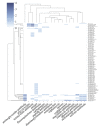Insights into the Vibrio Genus: A One Health Perspective from Host Adaptability and Antibiotic Resistance to In Silico Identification of Drug Targets
- PMID: 36290057
- PMCID: PMC9598498
- DOI: 10.3390/antibiotics11101399
Insights into the Vibrio Genus: A One Health Perspective from Host Adaptability and Antibiotic Resistance to In Silico Identification of Drug Targets
Abstract
The genus Vibrio comprises an important group of ubiquitous bacteria of marine systems with a high infectious capacity for humans and fish, which can lead to death or cause economic losses in aquaculture. However, little is known about the evolutionary process that led to the adaptation and colonization of humans and also about the consequences of the uncontrollable use of antibiotics in aquaculture. Here, comparative genomics analysis and functional gene annotation showed that the species more related to humans presented a significantly higher amount of proteins associated with colonization processes, such as transcriptional factors, signal transduction mechanisms, and iron uptake. In comparison, those aquaculture-associated species possess a much higher amount of resistance-associated genes, as with those of the tetracycline class. Finally, through subtractive genomics, we propose seven new drug targets such as: UMP Kinase, required to catalyze the phosphorylation of UMP into UDP, essential for the survival of bacteria of this genus; and, new natural molecules, which have demonstrated high affinity for the active sites of these targets. These data also suggest that the species most adaptable to fish and humans have a distinct natural evolution and probably undergo changes due to anthropogenic action in aquaculture or indiscriminate/irregular use of antibiotics.
Keywords: Vibrio; antibiotic resistance; genomic islands; molecular docking; one health; pan-resistome; subtractive genomics; virulence factors.
Conflict of interest statement
The authors declare no conflict of interest.
Figures








References
-
- Vezzulli L., Pezzati E., Brettar I., Höfle M., Pruzzo C. Effects of Global Warming on Vibrio Ecology. Microbiol. Spectr. 2015;3:3. doi: 10.1128/microbiolspec.VE-0004-2014. - DOI - PubMed
-
- Cardoso M.D., Lemos L.S., Roges E.M., de Moura J.F., Tavares D.C., Matias C.A.R., Rodrigues D.P., Siciliano S. A Comprehensive Survey of Aeromonas Sp. and Vibrio Sp. in Seabirds from Southeastern Brazil: Outcomes for Public Health. J. Appl. Microbiol. 2018;124:1283–1293. doi: 10.1111/jam.13705. - DOI - PubMed
LinkOut - more resources
Full Text Sources
Molecular Biology Databases

